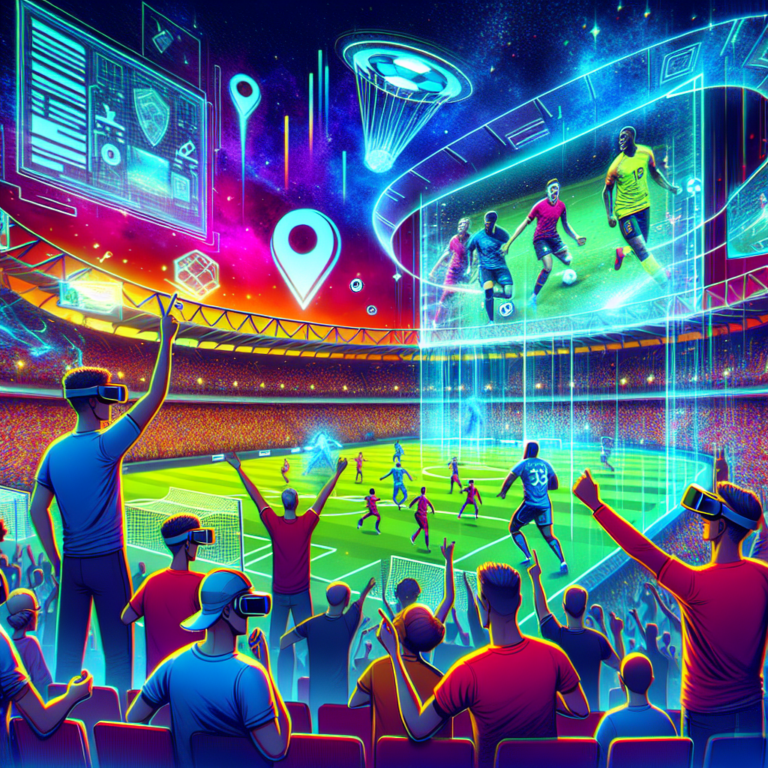Revolutionizing the Game: How XR is Transforming Live Sports Viewing
Understanding XR: The Future of Spectator Engagement
As technology continues to evolve, audiences are seeking more immersive experiences than ever. Enter Extended Reality (XR), a blend of Virtual Reality (VR), Augmented Reality (AR), and Mixed Reality (MR). This innovative approach is dramatically reshaping how we consume live sports, turning passive viewers into active participants. With XR technologies, fans are no longer just watching the game—they’re experiencing it in ways that were once the realm of science fiction! 🚀
The Benefits of Immersive XR Sports Viewing
Let’s dive deeper into how immersive XR experiences are enhancing live sports viewing:
- Enhanced Fan Engagement: XR offers an interactive environment where fans can explore 360-degree views, providing a more engaging and exciting way to enjoy the action.
- Real-Time Statistics and Information: With AR, useful information, player stats, and game highlights can be overlaid on the live action, allowing fans to feel like they’re right in the middle of the game.
- Social Interaction: XR allows for virtual gatherings of fans. Imagine watching a game with friends from around the world in a virtual stadium!
- Access to Unique Angles: Forget the traditional camera angles; with XR, fans can choose their own perspectives and watch the game from vantage points never previously available.
- Personalized Experiences: XR technology can adapt to fans’ preferences, providing tailored content and experiences, making every match feel unique and customized.
The Technology Behind XR Experiences
XR experiences utilize an array of cutting-edge technologies to create an immersive environment. Here’s a closer look at the essentials:
1. Virtual Reality (VR)
VR immerses the user in a completely virtual environment. Equipped with a headset, fans can feel as though they are sitting in the front row of their favorite stadium. The technology incorporates sound, touch, and interactive elements, making the entire experience mesmerizing and utterly realistic.
2. Augmented Reality (AR)
Unlike VR, AR overlays digital content onto the real world. Imagine pointing your smartphone or AR glasses at your favorite team’s logo and seeing historic wins, player stats, or even real-time game status pop up right in front of you! This adds layers of engagement without removing fans from their real-world surroundings.
3. Mixed Reality (MR)
MR is the fusion of AR and VR, allowing digital objects to interact with the actual world in real-time. This means that sports fans can see lifelike holograms of players, objects, and more during live games, creating an even more engaging environment.
Case Studies: XR in Action
Several organizations are already pioneering the integration of XR into sports viewing, setting a precedent for others to follow. Here are some standout examples:
1. NBA’s VR Experience
The NBA has partnered with tech companies to bring NBA League Pass VR to fans. This allows viewers to engage in virtual courtside experiences, providing an atmosphere that mimics the live audience experience. Fans can even choose where to sit, from the first row to a bird’s-eye view! 🏀
2. AR Enhancements in the NFL
During key games, the NFL uses AR to enhance viewers’ experience by providing up-to-date statistics and analyses. Fans can use their smartphones to access AR features that give them on-the-field insights as the game progresses, making them feel more connected to the action. 📊
3. Soccer and XR Integration
Clubs like Manchester City are utilizing immersive experiences to engage fans. Through AR, fans can experience highlights and interact with players during post-match analyses, creating a more interactive space for sports enthusiasts.
The Future of Sports Viewing: What Lies Ahead
The intersection of sports and technology is expected to evolve rapidly, driven in large part by advancements in XR. Consider the following futuristic possibilities:
- Hyper-Personalized Viewing: With user data, platforms could customize experiences based on individual preferences and past behaviors, making every viewing session distinct.
- Global Fans Unite: XR could facilitate global meetups through virtual lounges or arenas, uniting fans from disparate locations in unprecedented ways.
- Enhanced Training for Athletes: While viewing experiences for fans improve, XR can also revolutionize how athletes train and prepare for their games with simulations that mimic real-world scenarios.
- Sustainable Viewing: XR could significantly reduce the carbon footprint of fans traveling to and from stadiums by providing exhilarating viewing alternatives from home.
Overcoming Challenges in XR Sports Integration
Despite the excitement surrounding XR experiences, there are still challenges to overcome:
- Cost of Technology: XR implementation can be costly, both for franchises and fans. The technology needs to be accessible to widespread audiences.
- Quality of Experience: Poorly executed XR can hinder immersion rather than enhance it. Ensuring a seamless interface is critical.
- Fighting Against Traditional Media: Traditional broadcasters may resist XR technology, leading to possible competitive friction.
- Data Privacy: As personalized experiences rely heavily on user data, concerns regarding data privacy and security must be addressed.
Conclusion: Embrace the XR Revolution
The evolution of live sports viewing through immersive XR experiences is not just a trend but a significant shift. As organizations pave the way for innovative consumers’ interaction with sports, it’s clear that the future is becoming ripe with opportunities for enhanced engagement. One thing is certain—watching live sports will never be the same again! 🌟




0 Comments